|
| |

The Tabernacle
For 40 years the Tabernacle in the
Wilderness was the place where God communed with His people, Israel, as they
traveled through the desert on their way to the promised land. After the
establishment of the nation of ancient Israel the tabernacle became the center
of spiritual life for the congregation of the tribes. Not only did the
tabernacle house items of great spiritual significance, but they were a splendor
to see.

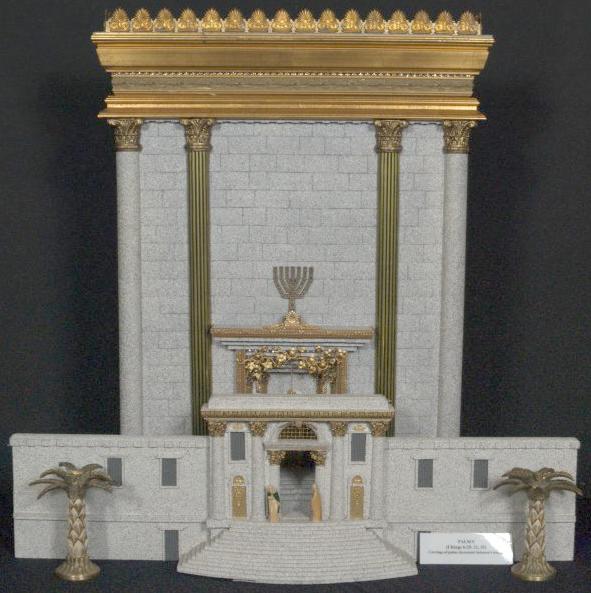
Solomon's
Temple and Nicanor Gate
The word "temple" is
derived from the Latin templum, signifying an uncovered place affording a
view of the surrounding region; in a narrower sense it signifies a place sacred
to the Divinity, a sanctuary. In the Bible the sanctuary of Jerusalem bears the
Hebrew name of Bet Yehovah (house of Jehovah). The sacred edifice
consisted of two chief halls, one called hekal (house or temple), or qodes
(the Holy), and the other debir (that which is the oracle), or godesh
haggodashim (the Holy of Holies). The New Testament speaks of it as oikos,
"the house", ouaos, Latin cella, "the most holy
place of the temple" and hieron, "the whole of the sacred
enclosure". The temple which Solomon erected to the Lord about 966 B.C. was
destroyed by Nabuchodonozor in 586 B.C. After the return from captivity
Zorobabel raised it again from its ruins (537 B.C.), but in such modest
conditions that the ancients who had seen the former Temple wept. In the
eighteenth year of his reign, which corresponds to 19 B.C., King Herod destroyed
the Temple of Zorobabel to replace it by another which would equal, if not
surpass in splendor, that of Solomon.
Many writers admit three temples
materially different. Now as the Prophet aggeus (Vulg., ii, 10) says of
that of Zorobabel: "Great shall be the glory of this last house more that
of the first", because of the coming of the Messias (v,8-9), they claim
that this prophecy was not fulfilled because Christ never entered the second
Temple. Others assert that Zorobabel's work was not completely destroyed
but gradually replaced by a larger and much richer temple (Josephus, "Ant.
Jud.," ed. Dindorf, XV, xi, 2), and they consequently admit only two
materially different temples. The whole difficulty disappears if we choose the
Septuagint in preference to the Vulgate. The Prophet has already asked:
"Who is left among you, that saw this house in its first glory? (ii, 4).
According to Septuagint he afterwards says: "The last
glory of this house shall be greater than its first glory." To the
Prophet, therefore, there was but one and the same house of Jehovah from Solomon
to the time of Messias, built always in the same place and according to the same
plan, that of the Tabernacle. We may therefore admit three different
temples: I. That of Solomon; II. That of Zorobabel; III. That of Herod.
From the Gate of Nicanor a
semicircular stairway (13) of fifteen steps led down to the women's court (14),
surrounded by a gallery on the north, east, and south. Here the women were
admitted and places were reserved for them on the north and south, but the men
also frequented this court and usually crossed it when they went to the Temple.
There were benches there, for it was permitted to sit (cf. Mark, xii, 41). Along
the sides probably near the Gate of Nicanor, were thirteen boxes, an inscription
indicating the special purpose of each: oil, wood, priestly vestments, doves,
etc. There Christ saw the rich men and the poor widow deposit their offering
(Luke, xxi, 1). At the four corners were four hypethral chambers, forty cubits
square (15). According to the Talmud the north-west chamber was where the
unclean and lepers, who had been healed, bathed and were declared clean by the
priests. In the north-east chamber the priests sorted the wood; in the
south-west oil and wine were preserved in vaults; in the south-east those who
had fulfilled the vow of Nazarites shaved their heads (cf. Num., vi, 13 sqq;
Acts, xviii, 18). In these chambers it was also permitted to wash, cook, etc.
According to Middoth, II, 5, there were also in this court four chambers in
which certain women were lodged.

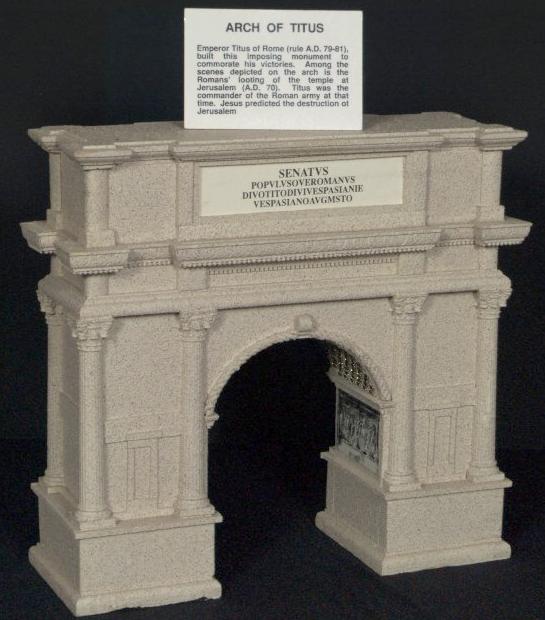
Arch of Titus -
Rome
Located at the highest point of
the Via Sacra which leads to the Roman Forum, this triumphal arch, with only one
passageway, commemorates Titus' conquest of Judea which ended the Jewish Wars
(66-70AD). Engaged fluted columns frame the passageway, the spandrels depict
Victories in relief, the attic contains an inscription "Senatus
Populusque Romanus Divo Tito Divi Vespasiani Filio Vespasiano Augusto" The
Roman Senate and People to Deified Titus, Vespasian Augustus, son of Deified
Vespasian. The internal faces of the passageway depict in relief
triumphal processions.
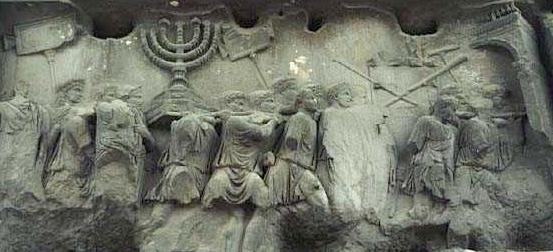
One scene depicts the triumphal
procession with the booty from the temple at Jerusalem--the sacred Menorah, the
Table of the Shewbread shown at an angle, and the silver trumpets which called
the Jews to Rosh Hashanah. The bearers of the booty wear laurel crowns and those
carrying the candlestick have pillows on their shoulders. Placards in the
background explain the spoils or the victories Titus won. The arch was erected
posthumously.

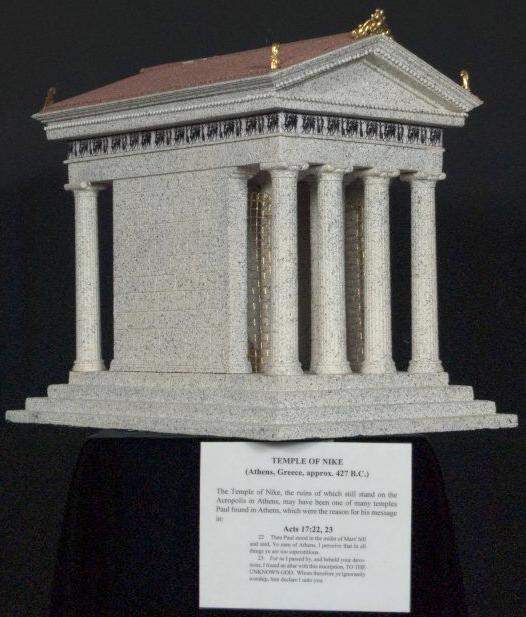
Temple of
Athena Nike - Athens
Designed by
Callicrates, Acropolis, Athens, c. 427 B.C.
The temple of Athena Nike, the
goddess of victory, is built on a small ledge outside the sacred precinct.
Designed by Callicrates, it has Ionic porticos of four columns on the front and
back of the cella. The entire building is surrounded with a frieze.
This may very well have been one of the temple Paul was referring to in his
message of Acts 17:22,23 -
22 Then
Paul stood in the midst of Mars hill, and said, Ye men of Athens, I perceive
that in all things ye are too superstitious.
23 For
as I passed by, and beheld your devotions, I found an altar with this
description, TO THE UNKNOWN GOD, Whom therefore ye ignorantly worship, him
declare I unto you.

|
Dome of the
Rock - Jerusalem
Mosque of Omar
- c. A.D. 691
"A compact, exterior octagon
enclosing a domed cylindrical core, the Dome of the Rock in its geometry and in
its parts—octagonal format, vaulting, columns, piers, arches, ambulatories,
rich mosaic decoration, and fenestrated dome of gilded wood, rebuilt in the
eleventh century—represented the Muslims' acquisition of a near-complete
Romano-Byzantine architectural program..."
"...the Dome of the Rock is
an atypical Islamic religious structure. The more characteristic Near Eastern
mosque—an early example being the Umayyad Great Mosque built within and
incorporating the ruins of the walls of a Roman temple precinct in the capital
city of Damascus—was developed to function, as had the Roman basilica, as a
large assembly place."
It is located in the old city,
above the Wailing Wall and sits on the most sought after piece of real estate in
the world, according to tradition the original site of King Solomon's Temple


An Egyptian
Temple
According to these
ancient people, Egypt was not just an earthly locality, but a reflection of
Heaven itself. To them, the world, the universe and man mirrored each
other.
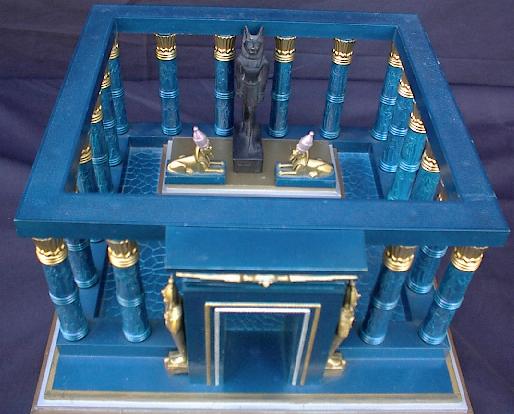

| |

Copyrighted © 2001-2004 Mishkan
Ministries, Inc. All Rights Reserved.
|
|
